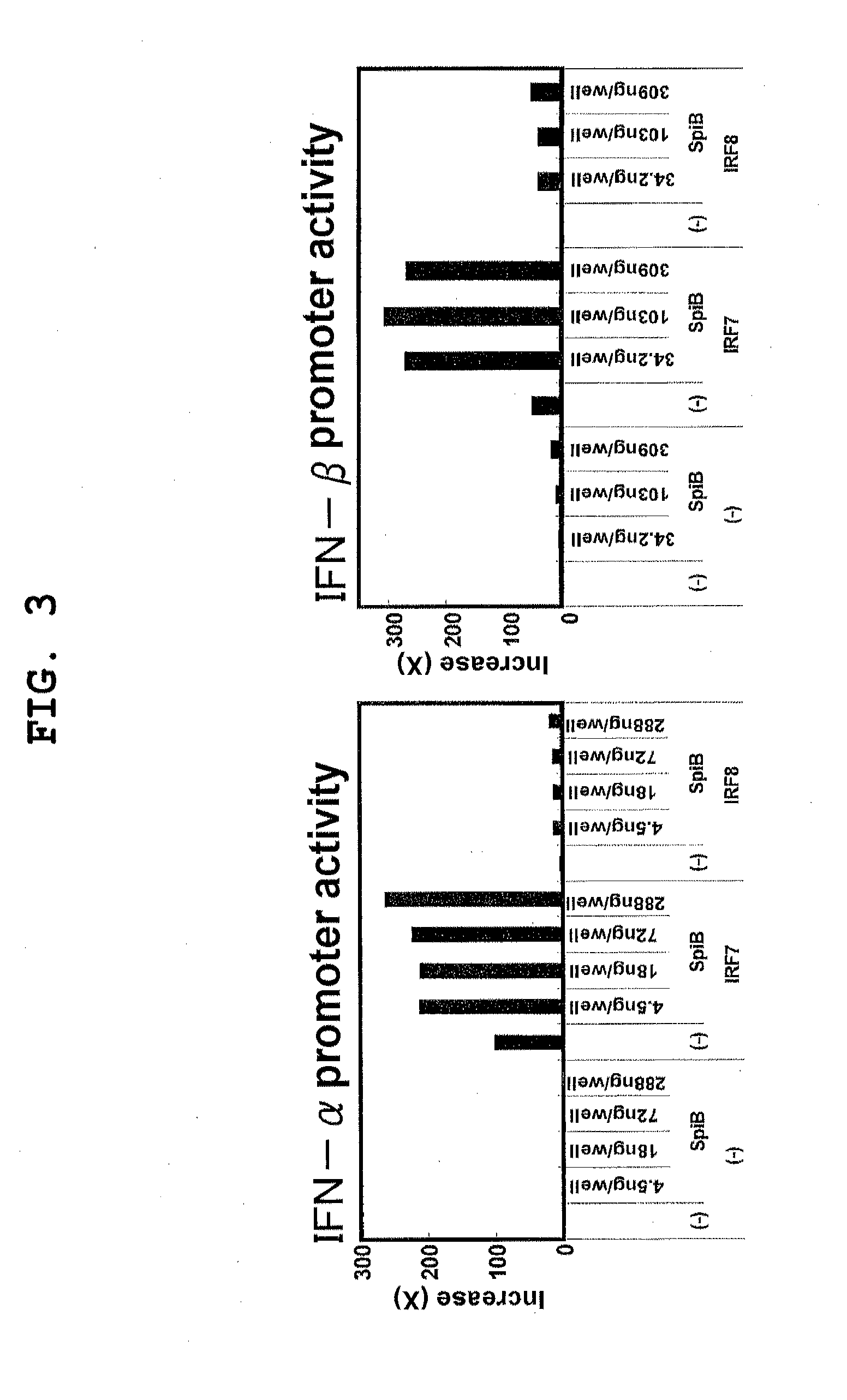Ifn type-i production inhibitor and method for screening for same
a production inhibitor and type-i technology, applied in the field of type-i ifn production inhibitors, can solve the problem that none of these molecules is highly expressed in pd
- Summary
- Abstract
- Description
- Claims
- Application Information
AI Technical Summary
Benefits of technology
Problems solved by technology
Method used
Image
Examples
example 1
Materials and Methods
Plasmids
[0135]The vector for luciferase expression driven by the IFN-α4 promoter was generated by subcloning the promoter region of the mouse IFN-α4 gene into the pGL3 vector (Promega) (non-patent document 9). The IFN-α4 promoter region was amplified by PCR using the primers shown below.
(SEQ ID NO: 16)Sense primer;5′-CCCCCACACTTTACTTTTTTGACAGAA-3′(SEQ ID NO: 17)Antisense primer;5′-TACAGGTTCTCTGAGAGCCTGCTGTGT-3′
[0136]The mouse IFN-α4 promoter used was a region consisting of the 433 bp from −486 bp to −54 bp upstream of the transcription initiation site of the IFN-α4 gene. At −163 to −152 of the region, a positive regulatory domain-like element (PRD-LE) has been identified as a site important to the gene expression (E. C. Zwarthoff, et al., Nucleic Acid Research 13:791-804, 1985; K. Honda et al., Int Immunol 17:1367-1378, 2005). In this mouse IFN-α4 promoter, the 135 bp from −188 to −54, including PRD-LE, is highly homologous to the human IFN-α4% promoter (72.2%)....
example 2
[0151]As in Example 1, the effect of human Spi-B expression vector on the expression of luciferase driven by a mouse IFN-β promoter, and the effect of human Spi-B siRNAs thereon were examined by luciferase assay.
[Materials and Methods]
[0152]The plasmid used for the expression of luciferase driven by the mouse IFN-β promoter was the same as that used in Example 1.
[0153]Human Spi-B expression vectors were prepared as described below. An HA-tagged human Spi-B cDNA fragment was amplified from the template Spi-B cDNA (Open Biosystems 4309499) by PCR, and subcloned into CSII-EF-MCS to obtain CSII-EF-HA-hSpiB, which was used.
[0154]The luciferase assay and a confirmatory test for the effect of Spi-B siRNA were performed in the same manner as Example 1.
[0155]The siRNAs against human Spi-B and control siRNA used had the sequences shown below.
siRNA-1Sense:GAACUUCGCUAGCCAGACCUU(SEQ ID NO: 28)Antisense:GGUCUGGCUAGCGAAGUUCUU(SEQ ID NO: 29)siRNA-2Sense:CUGGACAGCUGCAAGCAUUUU(SEQ ID NO: 30)Antisense...
example 3
[0158]To clarify the molecular mechanism by which Spi-B and IRF-7 cooperatively activate a type I IFN promoter, an examination was made to determine whether Spi-B and IRF-7 associated with each other.
[Materials and Methods]
[0159]293T cells were seeded to a 6 cm dish (1.4×106 cells / dish) and cultured overnight. Using lipofectamine 2000 (Invitrogen), a plasmid that encodes the HA-tagged mouse Spi-B gene (HA-SpiB-IRES2-venus, 4 μg) or a plasmid that encodes each FLAG-tagged mouse IRF family gene (pEF-BOS-FLAG-mIRF-3, pEF-BOS-FLAG-mIRF-5, pEF-BOS-FLAG-mIRF-7, pEF-BOS-FLAG-mIRF-8, 4 μg each) was transiently transfected to the 293 cells. As the control plasmid for pEF-BOS-FLAG-mIRF 3, 5, 7, and 8, pEF-BOS was used. 24 hours after the transfection, a cell extract was prepared using a RIPA buffer (50 mM Tris-HCl, 150 mM NaCl, 1% (v / v) NP-40, 0.5% (w / v) DOC, 0.1% (w / v) SDS, pH 8.0), and immunoprecipitated with an anti-HA antibody (MBL 561) or anti-FLAG antibody (SIGMA F1804); the immunopreci...
PUM
| Property | Measurement | Unit |
|---|---|---|
| body weight | aaaaa | aaaaa |
| heterogeneous | aaaaa | aaaaa |
| concentrations | aaaaa | aaaaa |
Abstract
Description
Claims
Application Information
 Login to View More
Login to View More - R&D
- Intellectual Property
- Life Sciences
- Materials
- Tech Scout
- Unparalleled Data Quality
- Higher Quality Content
- 60% Fewer Hallucinations
Browse by: Latest US Patents, China's latest patents, Technical Efficacy Thesaurus, Application Domain, Technology Topic, Popular Technical Reports.
© 2025 PatSnap. All rights reserved.Legal|Privacy policy|Modern Slavery Act Transparency Statement|Sitemap|About US| Contact US: help@patsnap.com



